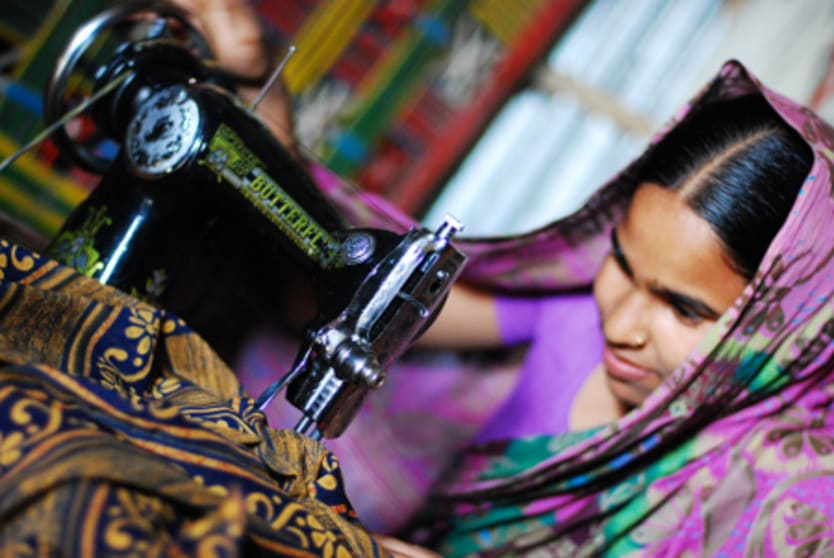
The poor aren’t penniless – that’s a common misperception. Microfinance aims to help them grow and better manage their small and often erratic finances.
Another fallacy: You have to be a banker to start a microfinance initiative.
Many different types of organizations use microfinance (or some form of it) as a part of health, gender, food security, post-conflict or even environmental initiatives. In Bangladesh, BRAC, the world’s largest NGO, bundles microcredit with health and education services.
Such initiatives have started and grown in many different ways. In Kenya, Jamii Bora Trust grew by collecting savings deposits from 50 street beggars in the late 1990s and now serves over 150,000 clients with microcredit, housing, business training and other services. Jamii Bora’s growth was helped along by international partners such as the Acumen Fund.
The PlaNet Finance Group, a global microfinance funder, has started microbanks in the nascent China market. Both China and Brazil are considered to be the last great frontiers for microfinance.
But even in countries where microfinance is long-established, there is still massive potential for expansion.
As the industry matures, so do its diverse players – from charities pushing sustainable development to global investors seeking a mix of lucrative profits and social good.
Grassroots banking 101
Microfinance provides financial services on equitable terms to those who are often not included in mainstream banking. The goal is to help the unbanked grow or sustain a small business, save money, pay for school fees, buffer emergencies or fund other activities to unlock their potential.
The origins of modern microfinance can be traced to experimental programs in Brazil, India and elsewhere during the 1970s by organizations such as Accion and SEWA. Most famous among these was a group lending model used by Muhammad Yunus and Grameen Bank in Bangladesh.
Here’s how they generally worked: Local villagers would form self-help groups. A microfinance institution would extend a small loan at a reasonable interest rate with short repayment cycles to group members. Each member would co-guarantee other members loans’ in case of a default.
Co-guarantees replaced the need for collateral to backstop a loan – a major barrier for the poor to borrower money. Frequent repayments helped ensure that the money would be paid back on time and not overwhelm the borrower. Interest rates were kept at a level that would cover administrative costs and raise capital for more loans. The group members also reduced the risk of lending, as they would keep out potentially unreliable borrowers.
A key principle of Grameen’s model was including women, perceived to be more reliable and responsible borrowers.
“To the extent that microfinance has had a positive impact on people’s lives and has had any contribution in the fight against poverty, a lot of that is attributable to the fact that women have been the principle clients,” says Mary Ellen Iskenderian, president and CEO of Women’s World Banking, a leading microfinance funder.
A global movement
Today, microfinance is a global movement with various approaches to financial inclusion for low-income populations. An estimated 1,200 plus MFIs reach more than 152 million borrowers globally, according to the Consultative Group to Assist the Poor, the World Bank’s microfinance research agency also known as CGAP.
As of 2007, there were $25 billion in outstanding microloans around the world, Deutsche Bank estimates. For a well-managed MFI, default rates as low as 2 percent are common.
Individual microloan terms and uses greatly vary by region but usually range in size from $50 to $1,000.
In the last decade, South Asia has seen the largest growth in microborrowers and -depositors, while Latin America had the largest growth in MFIs, according the Microfinance Information Exchange Inc., a clearinghouse for microfinance data.
At the grassroots level, microfinance providers range from international nonprofits such as World Vision to publicly traded companies like Equity Bank in Kenya. Globally, there is a diverse array of donors and commercial and social investors that support the growth of MFIs. Some of the major funders include ACCION, Bill & Melinda Gates Foundation, FINCA, Grameen Foundation, Kiva, Opportunity International and the World Bank. Other organizations such as MicroSave, Planet Rating and the SEEP Network provide technical assistance to MFIs.
The bubble bursts?
Despite the deluge of support for microfinance, an estimated 2.5 billion people remain unbanked globally. In order to scale and reach more clients, some MFIs have turned to commercial capital to grow. This trend, which emerged in the early 2000s, set off an ongoing debate in the microfinance community about the balance to strike between financial and social performance goals.
The debate was exacerbated by the near collapse of the microfinance industry in Andhra Pradesh, India, due to allegations of very high interest rates, harsh collection methods and profiteering by certain commercially funded MFIs in 2010.
Some experts suggest that with all the attention, funding and hype, the microfinance bubble is finally bursting. New regulations being proposed in various countries may also change the shape of the industry.
New horizons
Meanwhile, Microfinance continues to evolve in its sophistication and is branching-out into other sectors. For example, microsavings programs are becoming more common and may eventually overshadow microcredit as the product of choice by clients. Mobile banking through cell phones and other devices are linking microfinance to more rural borrowers. Microinsurance may become a gateway for the poor to access health care or recover from natural disasters. And financial literacy training is creating more savvy consumers. Some MFIs are even offering products that channel remittances from emigrants abroad to family members back home.
The growth of microfinance has also inspired a new generation of social entrepreneurs to use business approaches to address other global development challenges.








